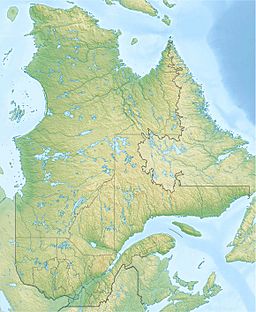Lake Jeannine facts for kids
Quick facts for kids Lake Jeannine |
|
|---|---|
| Location | Rivière-Mouchalagane, Caniapiscau, Quebec |
| Coordinates | 51°52′14″N 68°04′02″W / 51.8705556°N 68.0672222°W |
| Native name | Lac Jeannine Error {{native name checker}}: parameter value is malformed (help) |
| Max. length | 1.7 kilometres (1.1 mi) |
| Max. width | 800 metres (2,600 ft) |
Lake Jeannine (known in French as French: Lac Jeannine) is a small lake in the Côte-Nord region of Quebec, Canada. This lake was once a very important place for mining iron ore during the 1960s and 1970s.
Contents
Where is Lake Jeannine Located?
Lake Jeannine is found in a wild, undeveloped area called Rivière-Mouchalagane in Quebec, Canada. It is located just east of a main road, Quebec Route 389.
The lake is about 8 kilometres (5.0 mi) (5 miles) from Gagnon. Gagnon was a town that closed in 1985 and is now a ghost town! Lake Jeannine itself is 1.7 kilometres (1.1 mi) (about 1 mile) long and 800 metres (2,600 ft) (about half a mile) wide. Water flows out of the lake through old mine areas and smaller lakes, eventually reaching the Manicouagan Reservoir.
The name "Jeannine" was likely given to the lake by a prospector. This person worked for the Québec Cartier Mining Company. They were part of the team that found a huge amount of iron ore here in 1957.
The Big Mining Operation
The story of the mining here began on January 26, 1957. On that day, the Québec Cartier Mining Company was started by a company called U.S. Steel. Their goal was to get iron ore concentrate.
Building the Mine and Town
Between 1958 and 1961, a lot of construction happened:
- The mine itself was built.
- A town was built to house 4,000 people.
- The Hart-Jaune power station was created to provide electricity.
- A railway was built to connect the mine to Port-Cartier on the coast.
All this building cost about $325 million. The first shipment of iron ore concentrate left the mine in June 1961. From then until 1976, the mine employed over 1,000 workers.
How Iron Ore Was Processed
The plant at Lake Jeannine had 12 processing lines, all working the same way.
- First, the ore went through a process called autogenous grinding. This means the ore crushed itself using its own weight.
- Next, the ore was separated using a special system with spiral classifiers. This helped to get the valuable iron out.
- Finally, the cleaned ore was filtered to remove water. Then, it was shipped by train to Port-Cartier.
Mine Production and Closure
The iron ore deposit at Lake Jeannine was huge. It was 701 metres (2,300 ft) (2,300 feet) long, 243 metres (797 ft) (800 feet) wide, and 304 metres (997 ft) (1,000 feet) deep. This mine produced over 266 million tons of iron ore. The ore had an average iron concentration of 33%.
The mine was active from 1961 to 1976. In the 1970s, the company invested in new mining sites like Mont-Wright, Fermont, and Fire Lake. However, during a time when the steel market was struggling, the company had to close the Lake Jeannine mine.
The processing plant at Lake Jeannine continued to treat iron ore from Fire Lake until 1985. In that same year, both the processing plant and the town of Gagnon were completely closed down.
What's Left Behind
Today, about 127 million tons of mining waste, called tailings, cover an area of about 2.7 square kilometres (1.0 sq mi) (1 square mile). These tailings still contain nearly 10% iron. Another 26 million tons of tailings were put into the open pit mine, which is now filled with water.
In February 2007, a company called Quinto Mining from British Columbia announced they were looking into using the iron tailings from the old mine.


